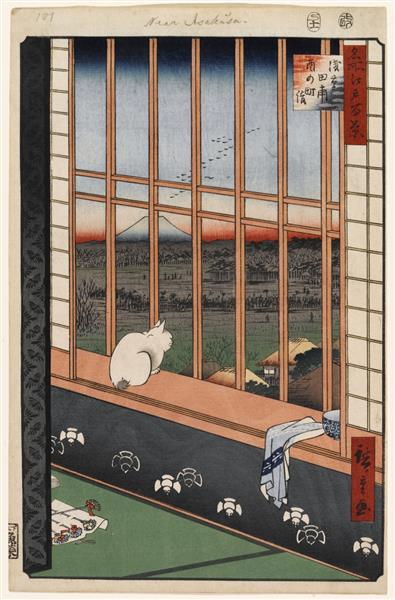Kuvaus
The painting "Asakusa Rice Fields Festival and Torinomachi - 1857" by Utagawa Hiroshige represents a fascinating example of the Ukiyo-e style that characterizes the Edo period in Japan. Hiroshige, one of the most recognized masters of this genre, captures in his painting a vibrant and festive moment, reflecting not only the natural beauty of the rice fields, but also the daily life and cultural traditions of his time.
At the top of the composition, a clear sky can be seen giving way to a dazzling white, suggesting a time of year ripe for festivities. As one moves down the image, the viewer is introduced to rice paddies, which are layered in shades of green and gold, suggesting not only the agricultural cycle but also the connection between nature and the work of man. The choice of colours in the palette, ranging from vibrant greens to the yellow and ochre tones of the rice fields, evokes a sense of abundance and vitality.
The sense of movement is another of the outstanding features of this work. Hiroshige manages to involve the viewer in the festive scene through the depiction of human figures moving towards the central event of the festival. Although each character is not detailed, the silhouettes suggest a community in full enjoyment, emphasizing the importance of social interaction at these celebratory events. The inclusion of the pennants fluttering in the wind adds a dynamism that imbues the scene with a palpable energy, resonating with the spirit of the festival.
The composition is carefully structured; the use of diagonal lines guides the viewer's gaze across the landscape, from the rice paddies to the distant presence of mountains and the sky. This use of perspective, although simple, is effective in creating depth and a sense of continuity in the depicted space. Furthermore, the arrangement of elements, now characteristic of the Ukiyo-e style, reveals Hiroshige's mastery in constructing a visual story that is not only aesthetically appealing, but also narrative.
The work is set in the broader context of Japanese art at the time, when Ukiyo-e began to gain popularity not only in Japan but also abroad, influencing Western art movements such as Impressionism. Hiroshige, along with other contemporary artists, used woodblock prints that captured urban and rural life, and "Asakusa and Torinomachi Rice Field Festival" is a testament to that fascination with the ephemeral world.
Although the work focuses on a specific event, capturing the essence of Torinomachi, it also stands as a reflection on the connection between man and nature, a recurring theme in Hiroshige's works. This balance between the human and the natural suggests a harmony that is characteristic of Japanese thought, highlighting the reverence towards the land and the customs that revolve around agriculture.
In conclusion, Utagawa Hiroshige’s “Asakusa and Torinomachi Rice Fields Festival – 1857” is not just a visual representation of a festive event, but encapsulates a rich cultural and social narrative that endures beyond the mere act of looking. Through his masterful use of color, form, and composition, Hiroshige invites the viewer to immerse themselves in a world that celebrates both the beauty of the natural environment and the vibrant life of its inhabitants. The work remains a lasting testament to Hiroshige’s artistry and ability to tell stories through his art.
KUADROS ©, a famous painting on your wall.
Hand-made oil painting reproductions, with the quality of professional artists and the distinctive seal of KUADROS ©.
Painting reproduction service with satisfaction guarantee. If you are not completely satisfied with the replica of your painting, we will refund 100% of your money.

